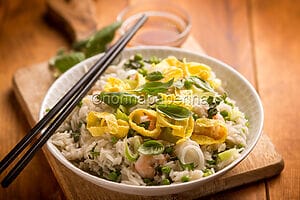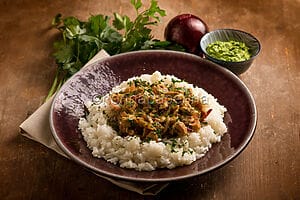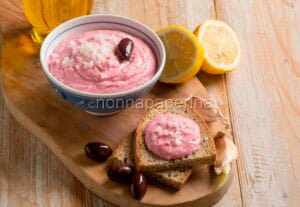
Taramosalata, a colourful and aromatic Greek sauce
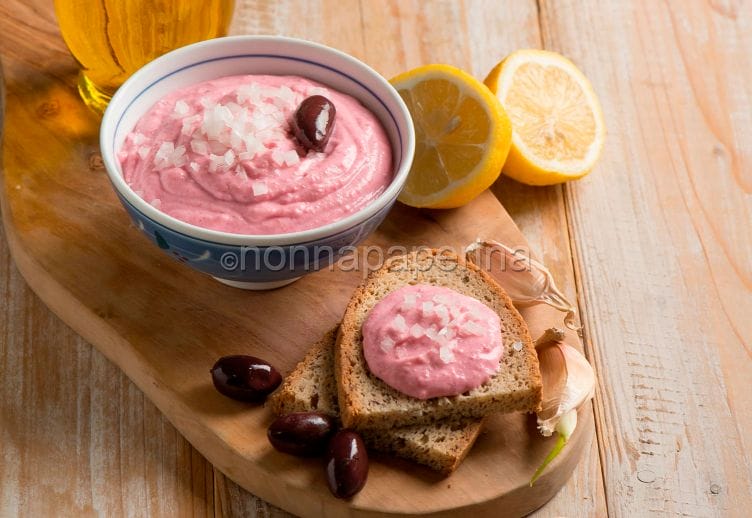
What is taramosalata, and how is it consumed?
Taramosalata is a typical dish of Greek cuisine, as its name suggests. It is considered an appetiser, although to a Westerner it might appear more like a condiment sauce. Specifically, it is made up of mullet roe, also known as “bottarga,” and other ingredients, which can vary depending on the variants. In fact, taramosalata is not a Greek exclusive but is also widely consumed throughout south-eastern Europe, primarily in Romania and Bulgaria, as well as in the Middle East, Israel, and Turkey in particular.
Regardless of its origin, the ways of consuming taramosalata are always the same. As an appetiser, it is spread on slices of bread, a bit like you would do with olive paté. It is often eaten alone, or at most with some light food as a side dish (tomatoes and, more rarely, fresh cheese). To be honest, the taramosalata I’m serving you today deviates slightly from accepted norms. This is because there are potatoes in the recipe; they are pureed and combined with the other ingredients. In this way, the taramosalata is given greater body and flavour.
Recipe taramosalata
Preparation taramosalata
- To make the taramosalata, place the onion slices in a bowl with three tablespoons of water, cover, and let soften for one hour.
- Meanwhile, wash and dry the lemons, then shred the peel, being careful not to grate the bitter white section.
- Boil the unpeeled potatoes, drain them, peel them, and mash them with a fork or potato masher to obtain a sort of puree.
- Now take an immersion blender and blend the softened onions, the mullet roe, 2 tablespoons of mashed potatoes, the oil, the grated lemon zest, a little lemon juice, and a little salt together.
- Keep half a teaspoon of lemon zest for decoration.
- If the mixture is too dry, add a little water (half a tablespoon will be fine).
- Once you have obtained a soft cream, add the other mashed potatoes and mix well with a spoon.
- Lastly, add the reserved lemon zest as a garnish.
- The taramosalata is now ready. It can be stored in the fridge for several days if well covered.
Ingredients taramosalata
- 300 gr. of mullet roe
- 4 large potatoes
- 1 onion
- 2 organic lemons
- 3 tablespoons of white wine vinegar
- 3 tablespoons of extra virgin olive oil
- salt and black pepper
- hot water
All the deliciousness of Mullet roe
What makes taramosalata unique is that its primary ingredient is mullet roe. It must be noted, nevertheless, that certain Middle Eastern variations—despite their similarities—use different components. The Israeli taramosalata, which favours cod roe, is specifically mentioned in contrast to the Turkish taramosalata, which employs carp roe. Both the texture and the taste are comparable, if not identical. The colour varies because each species of them has a unique colour rendering that sets them apart. The classic taramosalata, however, tends towards pink.

Going back to mullet roe, they are regarded as a delicacy that is “related” to and almost equal to caviar. They are valued for their nutritional content, which is largely independent of other fish products. For instance, 35% of mullet roe is made up of proteins, a proportion that is uncommon in diets derived from animals. Although they do contain 65% fat, it’s important to note that this fat is “good” fat and hence beneficial to your health. The reference is to omega-3 fatty acids, a panacea for the cardiovascular system, for visual and cognitive functions. The advice is, however, not to abuse this food, also because it is anything but dietetic. 100 grammes of mullet roe provide almost 400 kcal.
Which potatoes are appropriate for this recipe?
This taramosalata is characterized by the presence of potatoes. These are first boiled and then reduced to puree. One question that constantly comes up when discussing potatoes is: which kind should we use? Ultimately, the market is flooded with options. It is advised to utilise white potatoes in this situation because they are often softer and flourier and work better as puree.
Naturally, using regular yellow-fleshed potatoes will still make the recipe work, but white potatoes will undoubtedly have a softer, more uniform texture. They are similar in terms of nutritional content, among other factors. Good levels of carbohydrates, low levels of lipids, and a more than respectable mineral salt content define both types. Furthermore, they are not that caloric. The taste, however, is different compared to white potatoes, which usually express a greater delicacy.
Taramasalata or taramosalata is quick and easy to prepare. It will amaze everyone with its seafood flavour and its particular taste. After tzatziki, taramasalata is among the most well-known Greek foods worldwide. It goes well with bruschetta and fresh veggies. I advise you to give it a try! You’ll be grateful to me.
Why is taramosalata pink?
Anyone who looks at taramosalata for the first time is amazed first of all by its colour: a pink that sometimes tends towards bright, sometimes towards pastel, a strange colour for this kind of preparation. At first glance, it seems that the recipe contains colorant! But no, the colour comes only from the ingredients used, which are quite genuine. To be precise, the colour is due to the combined action of onion and vinegar. The onion must be red, while the vinegar is made from red wine.
The colour of taramosalata is one of the distinctive features of the recipe and one of the reasons tourists approach Greek cuisine with curiosity and enthusiasm. Even more so if the uses of the recipes are numerous.
A recipe with many variations
Although taramosalata is officially a Greek dish, it is also made in other eastern Mediterranean regions. Variants have emerged as a result of this extensive dispersion.
Take the Turkish variation, for instance, which is distinguished by a reduced use of starchy ingredients like bread and potatoes. Yoghurt is often used in their place, so the taramosalata sauce is less dense, softer, and at times smooth. Turkish taramosalata is not so much an appetiser as it is a spread.
The level of “liveliness” is the subject of additional variations. The addition of fish eggs and a generous amount of garlic is responsible for the Turkish version’s tendency towards savouriness and pungent flavour.
How is taramosalata flavoured?
One way to flavour taramosalata is to add a little garlic. This ingredient gives the dish a stronger flavour without throwing off the recipe’s balance. Typically, raw garlic is utilised to enhance the impact.
Although they are not part of the original recipe, you can also use dill and parsley. Dill is a herb that can enrich taramosalata, giving it a fresh and slightly citrussy note. Its thin leaves, with a delicate but distinctive flavour, pair well with the saltiness of the fish eggs, balancing the overall taste without overwhelming the other ingredients. Dill also adds a pleasant sensation of lightness to the dish.
Another adaptable herb that gives taramosalata some freshness and herbaceousness is parsley. Its mild bitterness creates a counterbalance to the richness of the olive oil and fish eggs. The addition of parsley not only enhances the flavour profile of the sauce but also gives the taramosalata a more visually appealing appearance.
Taramosalata FAQs
What is taramosalata?
Taramosalata is a traditional Greek and Middle Eastern sauce made from fish roe mixed with olive oil, lemon, vinegar, onion, and bread or potatoes. It has a creamy consistency and is often served as an appetiser or spread on bread and pita bread.
Where is taramosalata made?
Taramosalata is a traditional culinary speciality in Greece and other Eastern Mediterranean countries, such as Cyprus and Turkey. It is often made during Lent, when fish dishes are preferred to meat, but is still eaten year-round.
What does taramosalata taste like?
Taramosalata’s flavour is savoury, enhanced by the richness of ingredients like potatoes and bread. The flavour of the fish eggs is delicate but strong, with a slightly citrusy aftertaste thanks to the addition of lemon juice.
What does taramosalata go with?
Taramosalata pairs perfectly with pita bread, croutons or crackers. It is often served as an appetiser with olives, raw vegetables, and other Mediterranean foods. It can also be used as a salad dressing or paired with grilled fish or veggies.
Is taramosalata fattening?
Taramosalata, due to the olive oil and fish eggs, can be high in calories if consumed in large quantities. However, it is a sauce rich in healthy fats and proteins, so it remains a nutritious solution.
COULD IT BE INTERESTING FOR YOU

Vanillekipferl, traditional German tea biscuits
How did vanillekipferl biscuits come to be? Part of the history of vanillekipferl is unclear. On the other hand, it is believed that they originated in southern Germany in the 17th century. They...

Fried rice with shrimp and basil, a delicious...
Which rice should be used? Fried rice with shrimp and basil, like many comparable recipes, depends on proper rice management, beginning with variety selection. I suggest basmati rice for this...
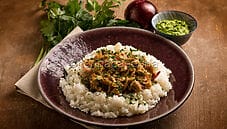
Chicken Yassa, a spicy and tasty Senegalese dish
Discovering Yassa chicken Yassa is a Senegalese dish made with chicken and rice, a complete dish that is appreciated for the variety of flavours and the massive use of spices. The recipe is...



















